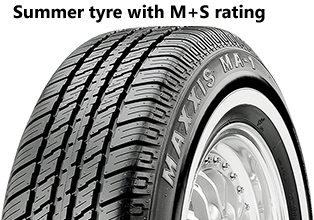As the cold season approaches, it’s worth to ensure that your car is ready to withstand any potential drop in temperature and snowfall. One of the first and the most essential items for your vehicle safety are the tyres. More specifically winter tyres In fact, their hugely increasing popularity is by no accident, from parcel couriers to corporate fleet managers, and from the private motorists to emergency services, more and more of us are coming to the realisation that mobility and safety can’t be left out in the cold. But can you recognise the difference between Winter tyres and M+S rated tyres?
As the tyres of your car are the only point of contact with the wet, icy, or snowy road, you have to ensure that you choose the right ones. Tyres that have M+S are different to winter tyres . There are generally speaking three tyre types summer, all-season and winter tyres all of these tyres can also carry the M+S rating but not all are suitable for winter driving. This is what you need to be careful about. So what is the differece and more importantly what type of tyre should your vehicle have for winter use.
What are M+S rated tyres?
Firstly M+S tyres feature the M+S symbol on the sidewall however not all M+S rated tyres are the same.
The M+S symbol on tyres sidewall means that the tyres have performance capabilities for both mud and snow conditions. However if you get the wrong M+S type of tyres ie M+S rated summer tyres you could find that you have loss of grip when trempratures fall using M+S rated tyres for winter conditions.
M & S tyres generally contain solid grooves and the tread blocks are spaced far apart than those on regular tyres.

How to identify M+S Tyres
M+S rated tyres can come in various types of designs and can even can look like an ordinary summer tyre as shown in the picture above. This tyre is a Maxxis MA-1 tyre which is M+S rated summer tyre it is very much like an ordinary tyre however there are subtle differences that define a M+S tyre mainly in the tread pattern. M+S rated tyres have slots or edges of pockets at angles ranging from 35 to 90 degrees from the travelling distance. To sum it all just remember that M+S means mud and snow and its not the same as a winter tyre. M+S tyres with the tread design that meets M + S definition are branded with the letters M and S in various ways such as M&S, MS, M+S, M/S, etc. according to the discretion of the tyre manufacturer.
What are winter tyres?
During the winter season, we all expect to face slippery roads as well as cold temperatures. Traditional tyres prove less efficient at gripping the road surface during cold temperatures whether its dry or wet, snowy or icy. Winter tyres come in handy since they are specially designed to grip the road tightly in all weather conditions falling below 7 degrees Celsius.
and according to tyres regulations of the United States and Canada and UNECE regulations (applicable in EU and several other countries). The snow performance of these tyres has to be proven through objective testing and meet or even exceed the defined limits. These tyres offer high performance concerning control and safety on icy, snow roads and in general at deep temperatures. Experts recommend using winter tyres bearing the Alpine symbol by the sidewall and a tread depth of not less than 4 mm during wintry conditions.
The high silica, flexible compounds of winter tyres allied to tread sipes that build a multitude of edges cope infinitely well with low-temperature conditions. Response and control levels leave the winter tyres standing or just spinning. Check out for the snowflake inside a mountain symbol on the sidewall. It indicates unspeakably high performance when the going becomes tough.

How can you recognise winter tyres?
Winter tyres contain the Alpine symbol as show in the image above.
There are two major differences between regular M+S rated tyres and M+S rated winter tyres features a different tread pattern of narrow slits and wider grooves at the very edges of the tread area that combine to offer a better grip on ice and snow. As shown in the image above.
The other difference is the material the tyre is created from. The rubber material employed for tread section on M+S tyres gets stiffer as the temperature lowers, and its grip begins to decrease below seven degrees Celsius. Winter tyres are made from a rubber material that stays soft and grippy to temperature even below zero. Summing up everything, tires that meet specified snow traction performance requirements of winter tyres features a peaked mountain pictograph with a snowflake at the centre.
Conclusion
If you want a tyre that is best for winter use then you require winter tyres look out for the alphine symbol on the sidewall of the tyre. Needless saying both you and your car need to get fully prepared for Winter. Driving with the right tires during winter will enhance your grip, maximise your safety and control enabling your vehicle to perform at it's maximum.